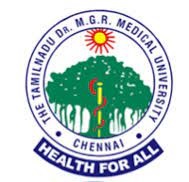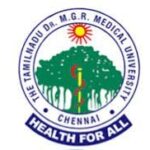
| University | The Tamil Nadu Dr.M.G.R. Medical University [TNMGRMU] |
| Course | M.B.B.S |
| Year | Second Year |
| Subject & Code | Microbiology II [6066] |
| Download | Question Bank |
| Document Type | |
| Official Website | https://www.tnmgrmu.ac.in/index.php |
TNMGRMU MBBS 2nd Year Microbiology II Question Bank
Download The Tamil Nadu Dr.M.G.R. Medical University [TNMGRMU] MBBS Second Year Microbiology II Question Bank 2022.
Download All TNMGRMU Question Banks Here
Download TNMGRMU MBBS 2nd Year Microbiology II Question Bank
| MBBS 2nd Year Microbiology II Question Bank | Download Here |
TNMGRMU MBBS 2nd Year Microbiology II Questions
March 2022 :
I. Essay: (2 x 15 = 30)
1. A 45 years old female has attended the Gynac op with c/o Mucopurulent vaginal discharge for the past one week. In gram’s staining of cervical swab, kidney shaped Gram negative cocci are seen. Answer the following questions
a) Which organism causes this symptoms and list out the other possible organism that cause Sexually Transmitted Infection.
b) Explain the pathogenesis and clinical feature of the organism
c) What are the diagnostic methods and management
2. A 55 years old male patient was admitted in ICU were with fever, cough with expectoration, fatigue and sore throat. There is H/O loss of smell and taste. The contact history with fever patient before 5 days is also elucidated
a) What is the cause of the above condition and list out other organism that causes interstitial pneumonia?
b) Explain the structure of the organism
c) How will you diagnose this condition .Add a note on its vaccine
II. Write Short notes on: (10 x 5 = 50)
1. Write about the lab diagnosis of Hepatitis B virus.
2. Explain various properties of enterotoxin produced by Escherichia coli.
3. Write the lab diagnosis of systemic mycosis.
4. Write short notes on carriers in typhoid infections.
5. Explain Weil-Felix Test and its application.
6. Write short notes on Brugian Filariasis.
7. Short notes on Granulomatous Amoebic Encephalitis.
8. Discuss the vaccine against Poliomyelits.
9. Write the clinical feature and lab diagnosis of Melioidosis.
10.Write the clinical feature and lab diagnosis of Plague.
August 2022:
I. Essay: (2 x 15 = 30)
1. A 65 year old male patient admitted in the hospital with history of fever, sore throat, head ache, body pain and loss of taste and smell. Symptomatic treatment was given. After 2 days, he developed difficulty in breathing, his oxygen saturation was <90 %. Blood investigations like CRP, D-dimer and IL-6 were elevated. CT Chest shows ground glass opacities. Patient was treated with high flow oxygen, steroid, antibiotics and antiviral agents.
a) What is the clinical condition?
b) Describe in detail about transmission, pathogenesis and clinical manifestations of this condition?
c) Write in detail about microbiological and non-microbiological investigations of this conditions?
d) Add note on prevention and control of this clinical condition?
2. A 17-year-old boy presented with bloody diarrhea with mucus and pus cells, colicky abdominal pain, fever, and prostration. The wet mount examination of the stool sample was performed which showed trophozoites of 5–20 μm, actively motile, with fingerlike pseudopodia. Inside the trophozoites, the ingested RBCs present?
a. What is the etiological diagnosis?
b. Describe the pathogenesis and clinical manifestations produced?
c. What are the various diagnostic modalities?
d. How will you treat this condition?
II. Write Short notes on: (10 x 5 = 50)
1. An 18-year old female presented with high-grade fever which rises every third day with chills and rigor. Her blood sample was subjected to a rapid diagnostic test which revealed positive for Plasmodium vivax. Discuss the laboratory diagnosis and treatment for the same?
2. A 40-year-old male presented with history of loss of appetite, malaise and jaundice of 2 months duration. On examination, there was icterus, hepatomegaly and tenderness in the right hypochondriac region. He gave a history of blood transfusion in the past. On laboratory examination, he was found to be positive for HBsAg.
a. What is the most probable etiological diagnosis?
b. Discuss in detail about the various viral markers, their laboratory diagnosis and prophylaxis of this condition.
3. A 25-year-old male with history of multiple sex partners is admitted with complaints of unexplained fever, progressive loss of weight, persistent diarrhea and generalized lymphadenopathy for the past 6 months.
a. What is the most probable diagnosis?
b. Discuss the pathogenesis and laboratory diagnosis of the above condition.
4. Rajesh, a 28-year-old male, was admitted to the hospital with complaints of evening rise of temperature, night sweat, loss of weight, loss of appetite and chronic cough with expectoration for the past 6 months. Sputum examination revealed long, slender and beaded acid-fast bacilli.
a. What is your provisional diagnosis?
b. Describe the laboratory diagnosis and drug resistance that occur in the etiological agent.
5. A 35 year old male with c/o hard painless penile ulcer attends STD OP. Blood sample drawn and sent for VDRL test. The laboratory reports VDRL test as Reactive. How will you counsel & what advice you will give to the patient.
6. Enlist the opportunistic fungal infection. Write in detail about the pathogenesis, clinical features and laboratory diagnosis of aspergillosis?
7. A 28-year-old female was admitted with high grade fever, vomiting, flank pain with increased frequency of micturition for the past 3 days. What is your clinical diagnosis, etiological agents and laboratory diagnosis?
8. A 25-year-old Australian visited his local doctor complaining of difficulty in swallowing liquids, loss of appetite and restlessness. He had a travel history to India one month back and did mention being bitten by a street dog.
a. What is the most probable etiological diagnosis?
b. Discuss the laboratory diagnosis and the vaccines available for human use.
9. List the bacterial organism causing pyogenic meningitis. Write in detail about clinical manifestations. laboratory diagnosis and treatment of pyogenic meningitis?
10.A 29-year-old female came to casualty with complaints of high-grade fever, severe joint pain, back pain and myalgia. Gradually, she developed petechial rashes over the body. On examination, she was found to have jaundice, hepatomegaly and a low platelet count (30,000/cm), Raised hematocrit (packed cell volume) by 20%. A tourniquet test done over the cubital fossa demonstrated 25 petechial spots/square inch area. On inquiry, she told that she has been bitten by the mosquitoes.
a. What is the clinical diagnosis and how is this disease transmitted?
b. How will you confirm the diagnosis in the laboratory?
Similar Searches:
tnmgrmu mbbs question bank, tnmgrmu mbbs question papers, mbbs question bank mgr university, tnmgrmu question bank, tnmgr university mbbs question papers, mgr university question bank mbbs, dr mgr university mbbs question papers, final year mbbs question bank pdf mgr university, mgr university mbbs question papers, 2nd year mbbs question bank pdf mgr university, dr mgr medical university question bank first year mbbs, dr mgr medical university question papers for bsc nursing, dr mgr university question papers bsc nursing, tnmgrmu e questions medical
Have a question? Please feel free to reach out by leaving a comment below
